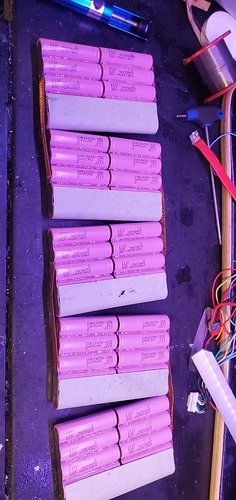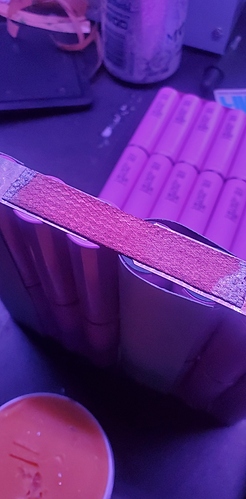They sag about 2.5v at 150A, they need a second parallel to distribute current :(, good for go-carts and utility vehicles but too large for esk8 methinks.
Anybody have a 26mm insulator ring source in US that has under a month ship times? @Skyart possibly?
Shoot you should have told me you need some, just pay shipping il send you 40 of em tommorow.
Anyone have a good technique for soldering copper braids to nickel on cells? I was thinking of soldering the copper braid to a piece of nickel and the spot welding the nickel with the soldered braid onto cells…what else you guys doing?
I solder after I weld because can’t easily get to the welds under the braid easily after the pack starts coming together…
What i do is, first I solder at the nickel between 2 cells, never over the top of one.
- Apply flux, scratch up the nickel and smear a coat of flux over.
- Hit it hot with the iron, large chisel tip, then right after with solder to make a little rectangle of solder across the nickel, not too much, just a coating almost
- Prep the braid by making a similar patch of solder in the braid. I use untinned copper because it doesn’t wick as much, I hold the copper braid with needle nose and that blocks any wicking past that point.
- Let the end of the braid get fully saturated with solder, while the solder is still hot, I push the braid onto the rectangle of solder on the nickel, the moment it fuses, I hit the pool of solder with a vaccum desolder gun, remove the iron while holding the braid down with the plastic vaccum puller. Let it cool, bingo.
this works for me…$0.02usd
edit: haha, @BluPenguin beating me to the punch!
- heat-sink the braid on either side of where you want the solder. the idea here is to keep those parts cool so the solder stays in a thin transverse strip and keep it from wicking and ruining the flex.
- wet out the braid along the strip you just made.
- cut the braid along the solder line. this should result in two nice clean edges. you can also check for how well you wetted the braid with solder.
- repeat as required to get the strips you need. I solder all cut edges of the braid.
- prepare to solder the strip to your nickel. Heat-sink the strip again to keep the solder down near the solder joint.
- run a bead of solder along the edge of the braid to form a nice fillet on the nickel.
should be a solid solder joint but still flexy
this works to solder braid to PCB’s as well
the heat sink is key, and this is a more elegant solution than I came up with😂
The goal is basically to apply a lot of heat, keep it from spreading and let the least amount get to the cells.
Iron should have a large tip for a lot of heat capacity. 850F or hotter, large alligator clips works well here too for blocking wicking
yeah that is what i am concerned about, the heat spread, ive seen pics of people soldering copper braid over a while p group…it does not feel like that is a good idea.
I’ve done it a few times now, still holding together. Most of the heat is absorbed by the copper, by the time the heat is on the nickel, you should already have good flow between the two. No significant heat is going to reach the cells, not in any level that will cause damage anyway.
This is good to know, do you happen to have any pics of this?
That red silicone positive wire, do you solder it to the battery every few inches? Is that what the black tape is covering up?
No cant be…wondering why it goes all the way back to that p group in the back
No, its only attached to the very last P group and bus down the + to the end of the pack where the - is. Follow the path, the P groups wind back and forth like an S
Close up pick of a braid I found:
I see you positive end is all the way at the end of the S shape and you needed a long wire to bring it to the front of the battery pack, you not concerned about that silicon wire wearing through the insulation and shorting?
That looks like a good idea too!!
No, underneath that you can’t see is heatshrink, and a strip of fish paper covered by harness tape (the cloth stuff they use to wrap wire looms in cars to prevent wear through). Then the entire pack is PVC heatshrinked. I’ve inspected packs after thousand miles with no visible wear through any part of insulation.




